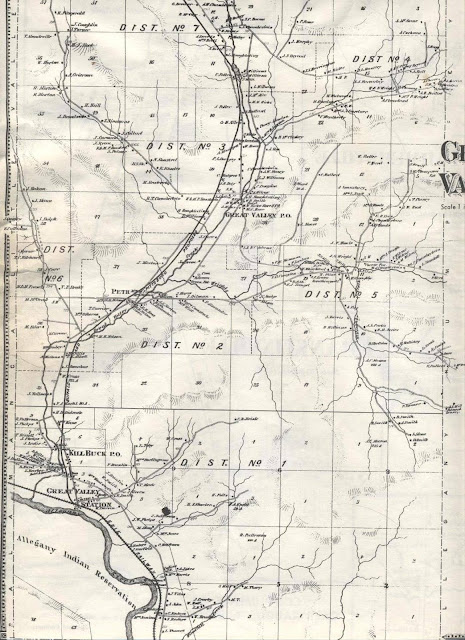 |
| 1869 Beers Map of Great Valley, Cattaraugus County, New York |
I
have written before that "Gaining
knowledge about an area and its history is invaluable to being
successful in family research."
Indeed, in my presentation on beginning your family history, I tell
people that out of the three key elements in family history research
(name, date and place), place is
the most important.
I
want to begin a new series on the town of Great Valley. Having a
reference map is a great place to start. This will help orient people
to the area. Although one might feel they know the area pretty well,
there is always something new to be learned. The concept of many
layers of knowledge about a subject matter is something I liken to
the metaphysical concepts in the theory of there being many particles
and waves in the universe which change when we focus our intent on
one particular aspect. There is almost no way to focus on more than
one aspect at any given time but that does not mean that there are
more layers overall. Time is another concept layer altogether. I will
leave further philosophical discussion about the universe for another
venue and others who are much more learned on the subject.
The
town of Great Valley will be celebrating its bicentennial in the year
2018. Preparations are being made to gather knowledge and plan
celebrations to commemorate the occasion. Cattaraugus County, in
which Great Valley is a part of, was formed in 1808. The town itself
was formed from Olean in April 1818 and changes occurred in 1831 (the
towns of Allegany and Humphrey, then known as Burton, were set off),
1842 (the town of Carrollton was formed) and 1847 (a portion of the
Indian reservation was taken off) before its present limits were
established.
The
principal sources of historical information on the town come from two
county histories, one written in 1879 and one written in 1893. A
Bicentennial History of the county was published in 2008 with
contributions from each town by their respective historians. The
scope of the bicentennial publication only lent itself to mainly
reiterating many facts originally established in the two earlier
histories. For the most part, the 2008 history provides only sparse
data on later historical events. Even the 1893 publication reuses
wording and facts from the 1879 history.
 |
| 1856 Map of Great Valley |
It
is difficult to celebrate a history without going back to the
beginning origins and even harder to move forward in time. Framed in
another philosophical way, Søren
Kierkegaard said that Life
can only be understood backwards; but it must be lived forwards.
It is often only with the passing of time that we can even begin to
look back in an effort to understand where we came from and where we
are going. In looking at it from the metaphysical perspective spoken
of earlier, we know that focusing on just one aspect narrows our view
of the big picture. Determining the exact focus of a historical
concept can be a daunting task. Inevitably something will be left
out. Even as we work to chronicle the past, the future marches on,
making this a never-ending task. I am cognizant of the human limits
that constrain the work of historical compilation. We are only one
part in the stream of history. Those who came before us are gone. We
will soon take our place among them, leaving the future to others. In
the preface to one of my family history book publications, I wrote
that I was adding “to the work that others before me,” built up
“from the foundations that were first laid by the very people whose
lives we attempt to chronicle.”
The
sources in my chronicle of the research on my ancestor John Goode
shown here at this blog post illustrate this
concept. You will note that chronologicallly four sources built upon
each other in the stream of time to establish the correct identity
and timeline for John Goode (ca. 1780-27 August 1814):
1887:
G.B. Goode
1930:
F.A. Virkus (editor)
1963:
William C. Stewart
1995:
Dawn Westfall
 |
| 1916 Map of Great Valley |
Later
research undertaken may have proven that the English origins of this
Goode family set forth by G.B. Goode are erroneous and will
undoubtedly continue to be a work in progress. It is something I will
leave for other historians to build upon.
Returning
to my original topic of the history of Great Valley, I believe
organization is key. Future posts on the subject will be my attempts
at organizing what I know. There are others who have participated in
the town's history for much longer than I who will undoubtedly have
more (and perhaps better) information. They may be able to focus more
in-depth on a particular topic. I can only give you what I have, add
what I know and have discovered. It is my hope that it will also be a
project that others will build upon in the future. Stay tuned for
future posts.
Comments
Post a Comment